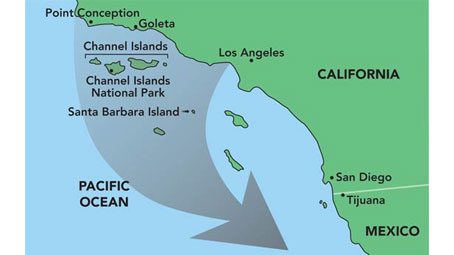Overhearing a Migration Secret: Using Sound to Track Swainson’s Thrushes
By Mike Powers July 15, 2010

Nick Lethaby was lying awake in the pre-dawn hours on Santa Barbara Island, 38 miles off the coast of Southern California, listening to dozens of Swainson’s Thrushes passing overhead. He recognized them by their characteristic flight call, a rising, bell-like pwee. But at sunrise he was hard pressed to find any thrushes on the island. Santa Barbara Island is a tiny island of low vegetation, so Swainson’s Thrushes should have been easy to find. Where could they have gone?
Birders visiting California’s other Channel Islands in fall report the same strange pattern: Swainson’s Thrushes are often heard at night but seldom seen during the day. On the adjacent mainland, Swainson’s Thrushes are downright uncommon. It’s as if the birds reach Point Conception, where the California coastline crooks eastward, and opt for a 200-mile shortcut over the waters of the California Bight to land in Mexico. If so, those night calls offer the only evidence of their passage.
An acquaintance of Lethaby’s, Wes Fritz, knew of flight-call studies that researchers from the Cornell Lab of Ornithology’s Conservation Science program were doing at nearby Vandenberg Air Force Base. We were studying migration using autonomous recording units that turn on shortly after sunset and record all night. Fritz thought that our tools might be able to document Swainson’s Thrushes passing over the Channel Islands, and we agreed to give it a try.
The units operate in all types of weather without human intervention, allowing us to collect sounds for detailed analysis when we get them back home. In addition to flight-call studies, we’ve used this technology to study the endangered Black-capped Vireo and Golden-cheeked Warbler, in searches for the Ivory-billed Woodpecker and Bachman’s Warbler, and to study hard-to-survey birds such as Whip-poor-will and Black Rail.
“The autonomous recording units perform as surrogate bird watchers, providing information that would otherwise be a logistical nightmare to collect,” Lethaby said. In August 2009, with permission from the National Park Service, he set up two units on Santa Barbara Island.
In mid-October Lethaby returned the units to the Cornell Lab, where we used special software to pick out those pwee notes. In this pilot season, we heard our first Swainson’s Thrush calls on September 5, just two days after the start of recording. Calls persisted through at least October 15. Migration progressed in fits and starts—on 13 nights our recording units heard no thrushes at all; on other nights we recorded dozens. The peak came on September 15, when we recorded 146 thrush calls. The most active calling typically happened just before sunrise each day.
Additional analyses and future deployments planned for this fall will fill in more of this story, such as possible reasons for the dramatic peaks and valleys in calling rates. Lethaby will continue monitoring on Santa Barbara Island, and we hope to record on neighboring islands to gauge how wide the river of migrating thrushes is. We may also learn whether other species use a similar over-water shortcut to their wintering grounds.
In the broader picture the potential for using acoustic monitoring in conservation research is tremendous. Flight calls are the only way we can reliably identify nocturnal migrant species, and most songbirds and shorebirds migrate at night. By listening in, we hope to uncover many more migration secrets.
Mike Powers uses acoustic technologies to track bird migration and animal communication for the Conservation Science program at the Cornell Lab.
Originally published in the Summer 2010 issue of BirdScope.


All About Birds is a free resource
Available for everyone,
funded by donors like you






